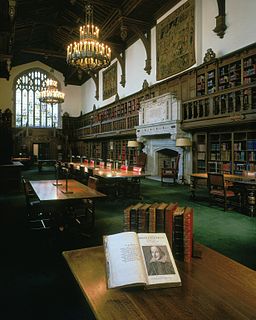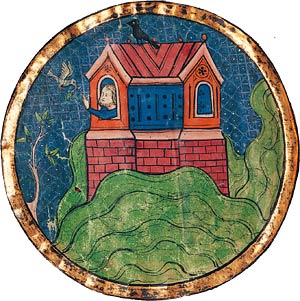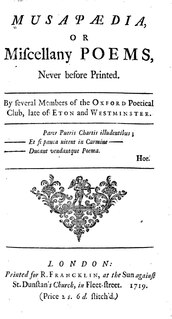
The earliest texts of William Shakespeare's works were published during the 16th and 17th centuries in quarto or folio format. Folios are large, tall volumes; quartos are smaller, roughly half the size. The publications of the latter are usually abbreviated to Q1, Q2, etc., where the letter stands for "quarto" and the number for the first, second, or third edition published.

The Folger Shakespeare Library is an independent research library on Capitol Hill in Washington, D.C., United States. It has the world's largest collection of the printed works of William Shakespeare, and is a primary repository for rare materials from the early modern period (1500–1750). The library was established by Henry Clay Folger in association with his wife, Emily Jordan Folger. It opened in 1932, two years after his death.

The Morgan Bible, also called the Morgan Picture Bible, Crusader Bible, Shah Abbas Bible or Maciejowski Bible, is a unique medieval illuminated manuscript. It is a picture book Bible consisting of 46 surviving folios. The book consists of miniature paintings of events from the Hebrew Bible, set in the scenery and costumes of thirteenth-century France, and depicted from a Christian perspective. It is not a complete Bible, as it consists largely of illustrations of stories of kings, especially King David. The illustrations are now surrounded by text in three scripts and five languages: Latin, Persian, Arabic, Judeo-Persian, and Hebrew. The level of detail in the images and the remarkable state of preservation of the work make it particularly valuable to scholars.

Edward Somerset, 4th Earl of Worcester, KG, Earl Marshal was an English aristocrat. He was an important advisor to King James I, serving as Lord Privy Seal.

Mr. William Shakespeare's Comedies, Histories, & Tragedies is a collection of plays by William Shakespeare, commonly referred to by modern scholars as the First Folio, published in 1623, about seven years after Shakespeare's death. It is considered one of the most influential books ever published.

The Cotton Genesis is a 4th- or 5th-century Greek Illuminated manuscript copy of the Book of Genesis. It was a luxury manuscript with many miniatures. It is one of the oldest illustrated biblical codices to survive to the modern period. Most of the manuscript was destroyed in the Cotton library fire in 1731, leaving only eighteen charred, shrunken scraps of vellum. From the remnants, the manuscript appears to have been more than 440 pages with approximately 340-360 illustrations that were framed and inserted into the text column. Many miniatures were also copied in the 17th century and are now in the Bibliothèque nationale de France in Paris.

The Castle of Perseverance is a c. 15th-century morality play and the earliest known full-length vernacular play in existence. Along with Mankind and Wisdom, The Castle of Perseverance is preserved in the Macro Manuscript that is now housed in the Folger Shakespeare Library in Washington, D.C. The Castle of Perseverance contains nearly all of the themes found in other morality plays, but it is especially important because a stage drawing is included, which may suggest theatre in the round.

False Folio is the term that Shakespeare scholars and bibliographers have applied to William Jaggard's printing of ten Shakespearean and pseudo-Shakespearean plays together in 1619, the first attempt to collect Shakespeare's work in a single volume. There are only two complete extant copies. One is part of the collection of the Folger Shakespeare Library in Washington, DC. The other is held in the Special Collections at Texas Christian University in Fort Worth, Texas.

The Ashbourne portrait is one of the numberless portraits that have been falsely identified as portrayals of William Shakespeare. At least 60 such works had been offered for sale to the National Portrait Gallery in the 19th century within the first forty years of its existence; the Ashbourne portrait was one of these. The portrait is now a part of the collection of the Folger Shakespeare Library in Washington, DC.
Lectionary 232, designated by siglum ℓ232 is a Greek manuscript of the New Testament, on parchment. Palaeographically it has been assigned to the 14th century. Scrivener labelled it by 226evl. Some leaves of the codex were lost.

The North French Hebrew Miscellany or "French Miscellany" or "London Miscellany" is an important Hebrew illuminated manuscript from 13th-century France, created c. 1278-98. A miscellany is a manuscript containing texts of different types and by different authors, and this volume contains a wide range of Hebrew language texts, mostly religious but many secular. The manuscript is exceptional among medieval Hebrew manuscripts both for its size and the diversity of the texts and the quality and lavishness of its illuminations, which as was often the case were added by Christian specialists.

A miscellany is a collection of various pieces of writing by different authors. Meaning a mixture, medley, or assortment, a miscellany can include pieces on many subjects and in a variety of different forms. In contrast to anthologies, whose aim is to give a selective and canonical view of literature, miscellanies were produced for the entertainment of a contemporary audience and so instead emphasise collectiveness and popularity. Laura Mandell and Rita Raley state:
This last distinction is quite often visible in the basic categorical differences between anthologies on the one hand, and all other types of collections on the other, for it is in the one that we read poems of excellence, the "best of English poetry," and it is in the other that we read poems of interest. Out of the differences between a principle of selection and a principle of collection, then, comes a difference in aesthetic value, which is precisely what is at issue in the debates over the "proper" material for inclusion into the canon.

The Dering Manuscript is the earliest extant manuscript text of any play by William Shakespeare. The manuscript combines Part 1 and Part 2 of Henry IV into a single-play redaction. Scholarly consensus indicates that the manuscript was revised in the early 17th century by Sir Edward Dering, a man known for his interest in literature and theater. Dering prepared his redaction for an amateur performance starring friends and family at Surrenden Manor in Pluckley, Kent, where the manuscript was discovered in 1844. This is the earliest known instance of an amateur production of Shakespeare in England. Sourced from the 1613 fifth quarto of Part 1 and the 1600 first quarto of Part 2, the Dering Manuscript contains many textual differences from published quarto and folio editions of the plays. Dering cut nearly 3,000 lines of Shakespearean text and added some 50 lines of his own invention along with numerous minor interventions. The Dering Manuscript is currently a part of the collection at the Folger Shakespeare Library in Washington, DC.

The Macro Manuscript is a collection of three 15th-century English morality plays, known as the "Macro plays" or "Macro moralities": Mankind, The Castle of Perseverance, and Wisdom. So named for its 18th-century owner Reverend Cox Macro (1683–1767), the manuscript contains the earliest complete examples of English morality plays. A stage plan attached to The Castle of Perseverance is also the earliest known staging diagram in England. The manuscript is the only source for The Castle of Perseverance and Mankind and the only complete source for Wisdom. The Macro Manuscript is a part of the collection at the Folger Shakespeare Library in Washington, D.C.. For centuries, scholars have studied the Macro Manuscript for insights into medieval drama. As Clifford Davidson writes in Visualizing the Moral Life, "in spite of the fact that the plays in the manuscript are neither written by a single scribe nor even attributed to a single date, they collectively provide our most important source for understanding the fifteenth century English morality play."

Embroidered binding, also referred to as needlework or textile binding, describes a book bound in textile, decorated with a design on both covers created for the individual book.

Thomas Trevelyon lived in England and is believed to have been an embroidery pattern drawer. He is long known for having compiled two large manuscript miscellanies, the Miscellany of 1608 now in the collection of the Folger Shakespeare Library, and the Great Book of 1616 now in the library at Wormsley Park. A third miscellany, in the collection of University College London was identified as being in his hand in 2012, and dates to circa 1603.
Anne Southwell [née Harris], later called Anne, Lady Southwell, was a poet. Her commonplace book includes a variety of works including political poems, sonnets, occasional verse, and letters to friends.
Sir Walter Bagot of Blithfield (1557-1622/3), was a landowner and Member of Parliament for Tamworth in 1586.

The Shakespeare coat of arms is an English coat of arms. It was granted to John Shakespeare, a glover from Stratford-upon-Avon, Warwickshire, in 1596, and was used by his son, the playwright William Shakespeare (1564–1616), and other descendants.

Heather Wolfe is an American curator of manuscripts and archivist at the Folger Shakespeare Library. A "Shakespeare detective", she has been noted for her research into the history of the Shakespeare coat of arms. She headed "Shakespeare Documented", a project to make contemporary texts involving Shakespeare available online, and is involved in the related "Early Modern Manuscripts Online" (EMMO) project.
















